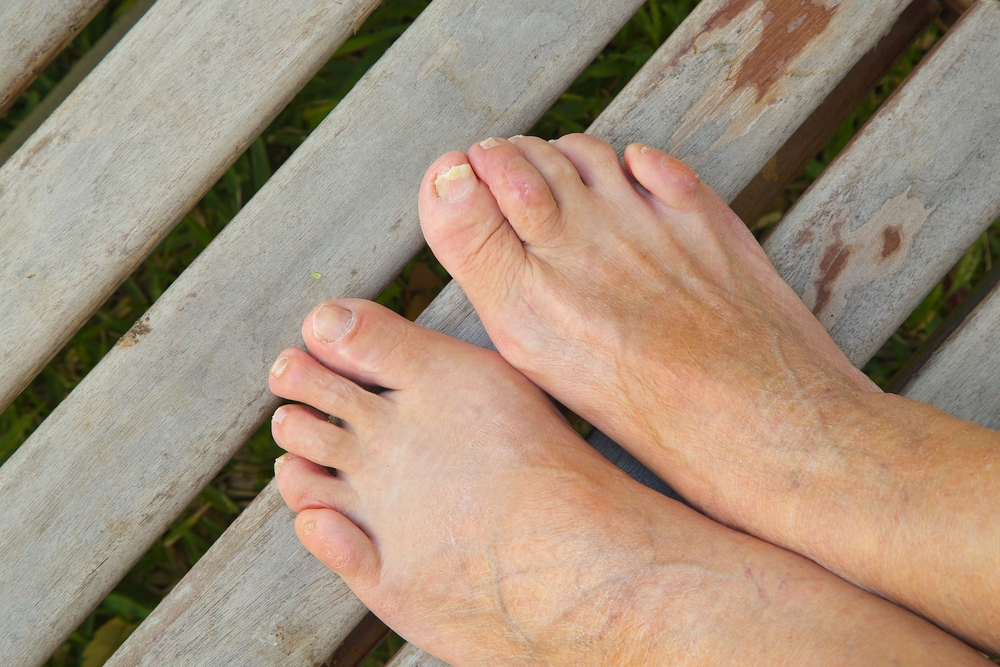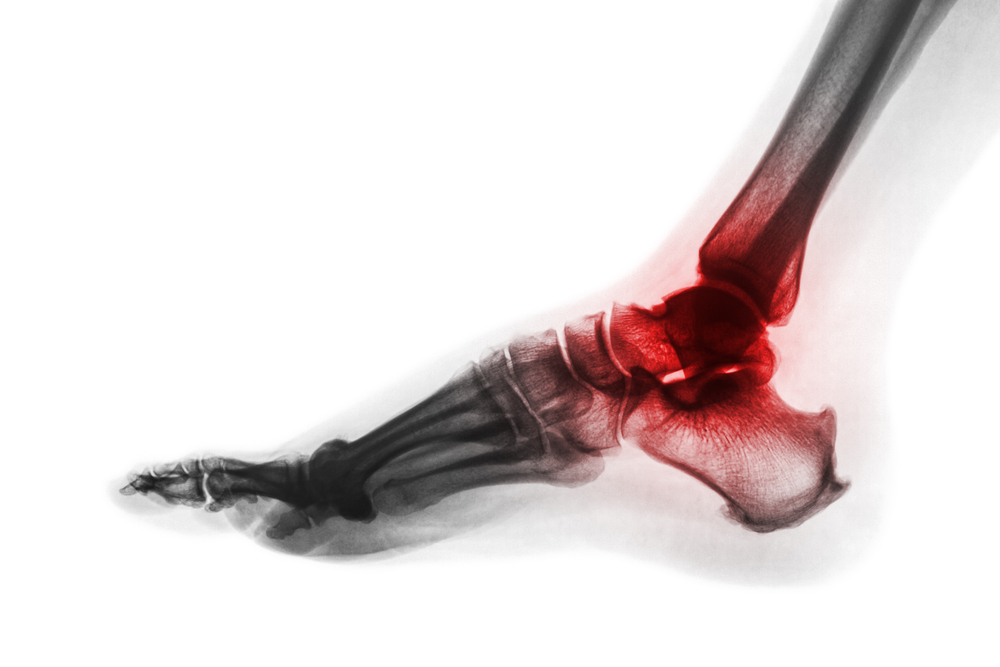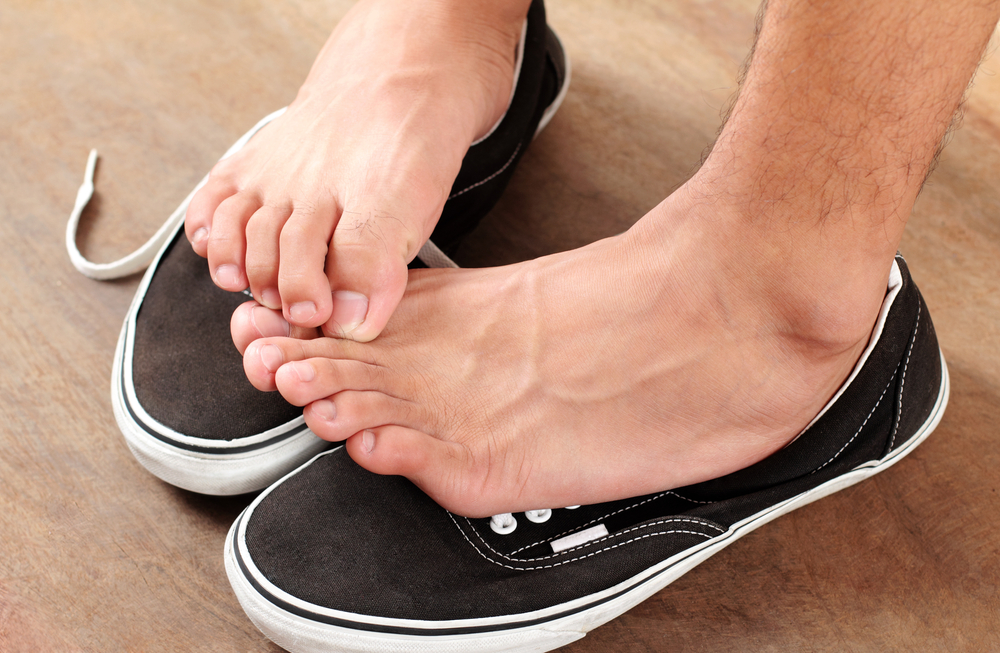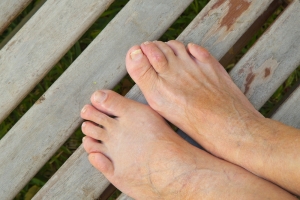Super User
What Can Cause Hammertoes?
 Hammertoe is a progressive foot deformity in which the toe bends down at the middle joint, giving the toe a hammer-like appearance. This can be both unsightly and uncomfortable as the tops of your toes rub up against the inside of your shoes. The constant rubbing and friction can cause corns and calluses to form on the tops of the toes. Hammertoes can be caused by an imbalance of the muscles and ligaments in the toes, wearing shoes that don’t fit properly, toes that squish together, shoes that have excessively high heels or a narrow toe box, and even flip-flops. Flat feet may also be a risk factor that contributes to hammertoe formation. If you develop hammertoe, please consult with a podiatrist who can offer you treatment options to slow the progression of your hammertoes as well as correct them.
Hammertoe is a progressive foot deformity in which the toe bends down at the middle joint, giving the toe a hammer-like appearance. This can be both unsightly and uncomfortable as the tops of your toes rub up against the inside of your shoes. The constant rubbing and friction can cause corns and calluses to form on the tops of the toes. Hammertoes can be caused by an imbalance of the muscles and ligaments in the toes, wearing shoes that don’t fit properly, toes that squish together, shoes that have excessively high heels or a narrow toe box, and even flip-flops. Flat feet may also be a risk factor that contributes to hammertoe formation. If you develop hammertoe, please consult with a podiatrist who can offer you treatment options to slow the progression of your hammertoes as well as correct them.
Hammertoes can be a painful condition to live with. For more information, contact one of the chiropodists of The Footcare Centre. Our chiropodists will answer any of your foot- and ankle-related questions.
Hammertoe
Hammertoe is a foot deformity that occurs due to an imbalance in the muscles, tendons, or ligaments that normally hold the toe straight. It can be caused by the type of shoes you wear, your foot structure, trauma, and certain disease processes.
Symptoms
- Painful and/or difficult toe movement
- Swelling
- Joint stiffness
- Calluses/Corns
- Physical deformity
Risk Factors
- Age – The risk of hammertoe increases with age
- Sex – Women are more likely to have hammertoe compared to men
- Toe Length – You are more likely to develop hammertoe if your second toe is longer than your big toe
- Certain Diseases – Arthritis and diabetes may make you more likely to develop hammertoe
Treatment
If you have hammertoe, you should change into a more comfortable shoe that provides enough room for your toes. Exercises such as picking up marbles may strengthen and stretch your toe muscles. Nevertheless, it is important to seek assistance from a podiatrist in order to determine the severity of your hammertoe and see which treatment option will work best for you.
If you have any questions, please feel free to contact our office located in Niagara Falls, ON . We offer the newest diagnostic and treatment technologies for all your foot care needs.
What Are Hammertoes?
Hammertoes are painful deformities that frequently form on the second, third, or fourth toe. The condition is often caused by an issue in foot mechanics. This can be caused by the person’s specific gait or the manner in which they walk, or by shoes that do not comfortably fit the deformity. Hammertoes can be formed after wearing shoes that are too narrow or short for the foot or have excessively high heels. Shoes that are not properly sized will force the toes into a bent position for long periods of time. This can cause the muscles to shorten and toes to bend into the deformity of a hammertoe.
Hammertoe can also be caused by complications from rheumatoid arthritis, osteoarthritis, trauma to the foot, heredity, or a cerebral vascular accident. Pain and difficult mobility of the toes, deformities, calluses, and corns are all symptoms of a hammertoe.
Someone who suspects they have the symptoms of a hammertoe should consult with a physician—particularly a podiatrist. Podiatrists diagnose and treat complications of the foot and ankle. If the podiatrist discovers that the affected toes are still flexible, treatment for the hammertoe may simply involve exercise, physical therapy, and better-fitting shoes. Treatment for hammertoes typically involves controlling foot mechanics, such as walking, through the use of customized orthotics.
For more serious cases in which the toes have become inflexible and rigid, surgery may be suggested. During the operation, the toe would receive an incision to relieve pressure on the tendons. A re-alignment of the tendons may then be performed by removing small pieces of bone to straighten the toe. In some cases, the insertion of pins is needed to keep the bones in the proper position as the toe heals. The patient is usually allowed to return home on the same day as the surgery.
If surgery is performed to repair a hammertoe, following the postoperative directions of your doctor is essential. Directions may include several stretches, picking up marbles with your toes, or attempting to crumple a towel placed flat against your feet. Wear shoes that have low heels and a wide amount of toe space to maintain comfort. Closed-toe shoes and high heels should be avoided. Shoes with laces allow the wearer to adjust how fitted he or she may want the shoes to be and also allow for greater comfort. To provide adequate space for your toes, select shoes that have a minimum of one-half inch of space between the tip of your longest toe and the inside of the shoe. This will also relieve pressure on your toes and prevent future hammertoes from forming.
Other preventative measures that can be taken include going shopping for new shoes in the middle of the day. Your feet are its smallest in the morning and swell as the day progresses. Trying on and purchasing new shoes midday will give you the most reliable size. Be sure to check that the shoes you purchase are both the same size. If possible, ask the store to stretch out the shoes at its painful points to allow for optimum comfort.
Osteoarthritis in the Feet
 Arthritis is a medical condition that causes the breakdown and eventual loss of cartilage in the joints. This can lead to pain, swelling, stiffness, and difficulty moving the affected joints. Osteoarthritis, which is associated with aging, is the most common type of arthritis and often affects the joints of the feet and ankles. Because of the pain and discomfort caused by osteoarthritis and the effect that it can have on mobility, it is important to seek treatment. Common treatments for arthritis include oral medications to reduce pain and inflammation, wearing orthotics in the shoes to cushion the feet and minimize pain, bracing or immobilizing affected joints, steroid injections directly into the affected joints to reduce inflammation, and physical therapy. If you believe you may have osteoarthritis in the feet, a chiropodist can help you manage this condition.
Arthritis is a medical condition that causes the breakdown and eventual loss of cartilage in the joints. This can lead to pain, swelling, stiffness, and difficulty moving the affected joints. Osteoarthritis, which is associated with aging, is the most common type of arthritis and often affects the joints of the feet and ankles. Because of the pain and discomfort caused by osteoarthritis and the effect that it can have on mobility, it is important to seek treatment. Common treatments for arthritis include oral medications to reduce pain and inflammation, wearing orthotics in the shoes to cushion the feet and minimize pain, bracing or immobilizing affected joints, steroid injections directly into the affected joints to reduce inflammation, and physical therapy. If you believe you may have osteoarthritis in the feet, a chiropodist can help you manage this condition.
Osteoarthritis in the feet or ankles can be a painful and disabling condition that may interfere with your daily activities. If you have arthritis, please consult with one of our chiropodists of The Footcare Centre. Our chiropodists will assess your condition and provide you with quality foot and ankle treatment.
What Is Osteoarthritis?
Osteoarthritis is a condition in which the protective layer of cartilage in the joints breaks down over time. This loss of cartilage causes the bones to rub together during movement, leading to pain and inflammation. Osteoarthritis is associated with aging, and often affects the small joints of the feet and ankles.
Symptoms
Symptoms of osteoarthritis include:
- Joint pain
- Joint stiffness
- Swelling in or around the joint
- Restricted range of motion
- Difficulty walking
Diagnosis
Osteoarthritis can be diagnosed through physical examination. You may also need to have an X-ray taken to assess the extent of the damage caused by the arthritis.
Treatment
Treatment for osteoarthritis focuses on reducing symptoms and improving the function of the affected joints. Conservative treatments include oral pain medications, orthotic devices, bracing or immobilizing the affected foot or ankle, steroid injections into the joint to reduce inflammation, and physical therapy. In more severe cases, surgery may be necessary.
If you have any questions, please feel free to contact our office located in Niagara Falls, ON. We offer the newest diagnostic and treatment technologies for all your foot care needs.
Arthritic Foot Care
Osteoarthritis is a condition in which the cartilage located on the ends of joints deteriorates over time. Cartilage is very important, as it protects and cushions the bones during movement. Osteoarthritis is the most common type of arthritis and is associated with aging. It can affect any of the joints in the body, and frequently affects the joints of the feet and the ankles.Though more rare, osteoarthritis can also occur as a consequence of an injury, such as as a sprain or fracture, or as a result of abnormal foot biomechanics.
Symptoms of osteoarthritis include pain and stiffness in the joints, swelling, and difficulty walking or bending the joints. In some cases, bony protrusions called bone spurs can develop on the affected joints. Osteoarthritis is a progressive condition, meaning that it worsens over time. Diagnosing the condition early allows for earlier treatment, which can help preserve the health and function of your joints.
A variety of treatment options are available for osteoarthritis. Pain can often be minimized by taking nonsteroidal anti-inflammatory medications, getting steroid injections into the affected joints, and wearing orthotics. Bracing or immobilizing the affected foot or ankle may help reduce inflammation and prevent deformity of the joint. Doing specific exercises can help strengthen the muscles in the feet and ankles to prevent injuries. In cases where more conservative treatments have failed or in which the arthritis has progressed significantly, surgery may be an option. If you have osteoarthritis in your feet or ankles, it is recommended that you consult with a chiropodist.
What Is Athlete's Foot?
 Athlete’s foot is a fungal infection of the skin on the feet. This fungus lives and thrives in warm, moist environments. Walking barefoot in public places such as swimming pools and locker room areas, sharing personal items like shoes and socks, having excessively sweaty or wet feet, or having a minor skin or nail injury on your foot can all make you more susceptible to athlete’s foot. If you have developed athlete’s foot, you may find that the skin on your feet is itchy, dry, cracking, peeling, or raw, especially in between your toes and on the soles of your feet. Potential treatments for athlete’s foot include oral and topical medications. If you are afflicted with athlete’s foot, a chiropodist can help find the right treatment for you.
Athlete’s foot is a fungal infection of the skin on the feet. This fungus lives and thrives in warm, moist environments. Walking barefoot in public places such as swimming pools and locker room areas, sharing personal items like shoes and socks, having excessively sweaty or wet feet, or having a minor skin or nail injury on your foot can all make you more susceptible to athlete’s foot. If you have developed athlete’s foot, you may find that the skin on your feet is itchy, dry, cracking, peeling, or raw, especially in between your toes and on the soles of your feet. Potential treatments for athlete’s foot include oral and topical medications. If you are afflicted with athlete’s foot, a chiropodist can help find the right treatment for you.
Athlete’s foot can be uncomfortable and unsightly. To learn more about preventing and treating this condition, please consult with one of our chiropodists of The Footcare Centre. Our chiropodists will assess your condition and provide you with quality foot and ankle treatment.
What Is Athlete’s Foot?
Athlete’s foot refers to an infection of the skin on the feet that is caused by a fungus. This fungus is contagious and thrives in warm and moist environments. It is often spread in common areas such as public pools, locker rooms, and showers. It can also spread when sharing personal items, like shoes or towels, with an infected person.
Symptoms
The symptoms of athlete’s foot may include:
- Itching, stinging, or burning of the skin on the feet
- Cracking or peeling skin, especially between the toes and on the soles of the feet
- Scaly, red rash on the foot
- Blisters
- Foul odor
Treatment
Treatment for athlete’s foot typically involves using over-the-counter topical antifungal medications on the feet. When over-the-counter options are ineffective, you may need to take prescription oral medications or topical antifungal drugs, or a combination of both.
Prevention
Preventing athlete’s foot places an emphasis on good foot hygiene practices.
You can prevent athlete’s foot by:
- Washing and drying your feet thoroughly every day
- Wearing shoes when walking in public areas
- Not sharing personal items, like shoes or socks, with others
- Wearing shoes and socks made out of breathable materials
If you have any questions, please feel free to contact our office located in Niagara Falls, ON. We offer the newest diagnostic and treatment technologies for all your foot care needs.
Athlete’s Foot
Athlete’s foot, also known as tinea pedis, is a fungal infection of the skin of the feet. The fungus that causes athlete’s foot lives and thrives in warm, moist environments such as public swimming pools, locker rooms, and showers. This fungus can infect the feet through a cut or crack in the skin. Athlete’s foot is also highly contagious, and the fungus can spread from person to person through sharing personal items such as shoes, socks, or towels.
The symptoms of athlete’s foot include itching, stinging, or burning between your toes or on the soles of your feet, itchy foot blisters, and dry, cracked, or peeling skin on the feet. The infection can also spread to your toenails, leading to discoloration, thickening, and crumbling.
Through a physical examination, athlete’s foot can be diagnosed by your chiropodist based on its symptoms. Sometimes, a skin test may be ordered to confirm the diagnosis. Athlete’s foot can be treated with both oral and topical over the counter or prescription medications. You can prevent a fungal infection by maintaining good foot hygiene, wearing shoes when walking in public areas, avoiding sharing personal items with others, and keeping your feet clean and dry.
If you have symptoms of athlete’s foot, please consult with a chiropodist for treatment.
Stuart Berry, Chartered Scientist
Chartered Scientist is a professional registration that represents a single chartered mark for all scientists, recognising high levels of professionalism and competence in science. There are currently over 13,000 Chartered Scientists working in a vast array of settings and across all scientific and related sectors. The Chartered Scientist is amongst an array of chartered professionals who will have gained a specific level of skill or competence in a particular field of work, which has been recognised by the award of a formal credential mainly by chartered professional bodies and learned societies.
The College of Podiatry has been awarded Licensed Body Status by the Science Council, therefore members of the College of Podiatry (a UK professional association) can apply to become a Chartered Scientist.
Being chartered is the mark of professional recognition. Being a Chartered Scientist allows all scientists working at the full professional level to be recognised on an equal footing.
It gives an assurance of current competence through mandatory revalidation and encapsulates the interdisciplinary nature of science in the 21st Century.
By benchmarking professional scientists at the same high level, CSci aims to re-engage public trust and confidence in science and scientists.
All those working in the practice, application, advancement, or teaching of science can become CSci with the appropriate combination of qualifications and experience.
Chartered Scientists work in an ever growing, diversity of settings, from food science to environmental waste management, health psychology to nuclear physics, and mathematical modelling to chemical engineering.
Applicants must demonstrate various competencies including the ability to deal with complex issues and communicate their conclusions to a range of audiences
They show originality in problem solving and substantial autonomy in planning and implementing tasks
Through a commitment to continuing professional development, Chartered Scientists will continue to advance their knowledge, understanding, and competence throughout their career.
The Science Council require that individuals registered as a Chartered Scientist demonstrate their commitment to continuing professional development (CPD) within their careers.
For me, I always knew I wanted to go into the medical or allied medical fields from a very young age and naturally gravitated towards the sciences. I had seen first-hand the impact of Type I Diabetes with my extended family and was peripherally recognisant of the role of podiatric medicine having experienced going to a chiropodist as a child with some plantar warts.
Upon commencing my training at the University of Salford, I found I loved it – it was organically a good fit for my scientific mind and my practical hands and my friends on other programs experienced my evangelical enthusiasm whilst studying my BSc (Hons) Podiatry undergrad.
I graduated in the class of 1997 pleased as punch attaining a first class honours.
I have always liked the fact that our chosen field seeks the highest levels of empirical evidence and our decisions on care, treatment or clinical management are based on research. It is reassuring for patients and it is reassuring for us as clinicians.
Like most I went on to practice the science of podiatric medicine within the UK when I fifers qualified – BSc (Hons) Podiatry in hand! Not only that but to practise the practice of my science. Through ongoing, continued development and redevelopment, over those early years and the decades since, I have honed skills, deepened, and broaden my science-based podiatric practice and become an evidence-based clinical manager.
Being a Chartered Scientist has given me the opportunity to demonstrate a level of competency that excels in the science of podiatric medicine. It is great to be able to demonstrate these competencies to patients, co-workers, and the wider scientific community.
I have found that it has opened many new and positive conversations and questions pertaining to my clinical specialty, and now that I am additionally able to practice in Ontario, within the chiropody /chiropodist scope, it has certainly increased understanding within the office with regards to scope of practice, re-emphasising the place of the science of podiatric medicine as part of the wider medical sciences.
I have been pleased that my accomplishments and post-graduate study enabled me to work in two continents- with offices in both the UK and Ontario, Canada. I have been able to build professional links with other like-minded clinician-scientists in Canada and have actively worked on the board of the Canadian Federation of Podiatric Medicine.
My general role is split between clinical practice 70% of my time, with the remainder focussed on clinical management activities such as team, leadership, and development activities. Enjoying the full scope of professional practice, I look forward to and remain committed to, the ongoing development of my team, my environment, and practice of this interesting science and look forward to the opportunities it affords me in the future.
Stuart Berry, CSci
Recruitment — Join Us!
Our office is dynamic, growing, and diverse!
This makes for a great, exciting place to work and means there are often opportunities available for team members to develop, grow, or new team members to join our team of chiropodists or support staff.
What is it like working here? Click here to watch our video to find out more.
What makes us get out of bed in the morning?
By offering the Care, Professionalism, and Time that feet deserve, our goal is to be the # 1 choice that comes to mind when people think about footcare.
WHAT WE DO: We treat patients who are suffering from various foot-oriented problems & help by providing structured plans to improve foot health, reduce pain & promote healthy active living, while maintaining a better level of care.
HOW WE DO IT: We combine a professional approach with evidence-based, tailored care solutions. We take the time to clearly communicate with patients the various options available and suggest appropriate courses of action.
WHY WE DO IT: We believe all feet deserve to be healthy and we truly enjoy making an impact on people's lives.
What about quality of care?
Des Armstrong and Stuart Berry are the office and chiropody managers respectively. Learn more about the management style here.
Through the college of Podiatry, Stuart has achieved Chartered Scientist status and has achieved accreditation for the office.
What next?
Do you think you are a good fit for The Footcare Team Centre team?
We want to hear from you!
Tell us why today here.
Manager Coaching by Stuart Berry
I love managing. Back when immigrating to Canada it was my skill as “healthcare manager” that Canada both recognized and wanted. This enabled fast track application as a federal skilled worker all those years ago.
I have been a Chiropodist for, what, going over 24 years now and a healthcare manager for 17 years. Over that time, I have loved the rewards managing brings. I see myself as a collaborative leader - one which enjoys utilising the skills of my team in both undertaking tasks but also in making decisions. I rely on my team day in, day out, but I always ensure they know I am available and approachable.
Developing my team, which spans two continents, with thriving offices in the UK and in Niagara Falls Canada is key to everyone’s success: patients, team members, The Footcare Centre itself. Each team member thrives through development. I utilise goals and objectives as a tool to further my team’s development - I have them and each team member has them. We grow together.
If you ever attend our offices as a patient, you will experience a professional yet laid back approach - you will experience quality care, but hopefully enjoy the experience too! I cultivate this culture with my team, our team ethic and our vision and mission.
Who are we as a team?
“By offering the Care, Professionalism and Time that feet deserve, our goal is to be the # 1 choice that comes to mind when people think about footcare.
WHAT WE DO: We treat patients who are suffering from various foot-oriented problems & help by providing structured plans to improve foot health, reduce pain & promote healthy active living, while maintaining a better level of care.
HOW WE DO IT: We combine a professional approach with evidence based, tailored care solutions. We take the time to clearly communicate with patients the various options available and suggest appropriate courses of action.
WHY WE DO IT: We believe all feet deserve to be healthy and we truly enjoy making an impact on people's lives.”
I love coaching, one-to-one development, inducting new team members, and mentoring those who need it. There is nothing more rewarding than mentoring a colleague to become a better version of themselves.
I truly thrive on managing “the business” too: the numbers, the statistics, testing, and measuring. I test and measure pretty much everything in our business. By measuring, we can improve as a team, as a service, and improve our outcomes on the care we deliver. This is where management-meets healthcare-meets science and I use my skills as a chartered scientist in my business management and care.
Do you think you are a good fit for The Footcare Team Centre team? Tell us why today here.
Stuart Berry, CSci



